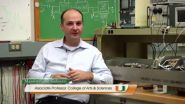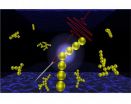(Press-News.org) VIDEO:
Despite saving thousands of lives yearly, nearly half of organ transplant surgeons report a low sense of personal accomplishment and 40 percent feel emotionally exhausted, according to a new national...
Click here for more information.
DETROIT – Despite saving thousands of lives yearly, nearly half of organ transplant surgeons report a low sense of personal accomplishment and 40% feel emotionally exhausted, according to a new national study on transplant surgeon burnout.
The findings will be presented at the 2014 World Transplant Congress on Wednesday in San Francisco.
Senior staff psychologist Michelle Jesse, Ph.D., led the Henry Ford Transplant Institute study, with liver transplant surgeon Dr. Marwan Abouljoud and Henry Ford senior staff psychologist Anne Eshelman, Ph.D.
"Burnout is common in medicine, especially in high-pressure specialties like transplantation," says Dr. Abouljoud, director of the Henry Ford Transplant Institute. "Organizations who employ those at increased risk for burnout should develop systems to prevent it and develop sustainable workforces."
Burnout is characterized by high emotional exhaustion, high depersonalization and low levels of personal accomplishment, Dr. Jesse says, explaining people with burnout often feel emotionally drained, overextended and distant or having a lack of feelings toward patients.
In the survey of 218 transplant surgeons – 86.7% men, ranging in age from 31 to 79 – 46.5% reported a low sense of personal accomplishment. Additionally, 40% of the transplant surgeons reported feeling a high level of emotional exhaustion. Yet only 17% of transplant surgeons reported high levels of depersonalization.
"This combination suggests that transplant surgeons are extremely invested in and engaged with their patients but they are frustrated by the process," Dr. Jesse says. She explained that transplant surgeons' patients are often critically ill, take a long time to recuperate and sometimes die waiting for an organ, all which could affect feelings of personal accomplishment.
Transplant surgeons who felt less burned out and reported higher levels of personal accomplishment said they felt more control in their work life and had more support from co-workers. Although they often had to talk with patients about difficult and stressful medical issues, they were more comfortable and prepared for these discussions than surgeons who were more burned out.
"Difficult patient interactions – like patients and families angry or crying while discussing end of life decisions – are not uncommon for transplant surgeons," says Dr. Jesse. "Those are hard conversations to have with patients who are sick. Our data suggests that those who are more comfortable with those conversations may be at less risk for aspects of burnout."
Surgeons who reported greater depersonalization also reported less co-worker support, greater psychological demands and more discomfort with difficult patient interactions. Transplant surgeons who felt more emotionally exhausted said they had greater psychological demands, less co-worker support and less decisional authority.
Henry Ford researchers expect to continue to study multi-faceted approaches to addressing the issues of burnout in transplant surgeons.
"It's about creating a culture that allows them to thrive and supports them," Dr. Jesse says. "First we have to understand what contributes to the development of burnout and then tailor interventions to their needs."
INFORMATION: END
Henry Ford study: Burnout impacts transplant surgeons
2014-07-28
ELSE PRESS RELEASES FROM THIS DATE:
Many people never grow out of their growing pains
2014-07-28
Over the years, many adolescents have been forced to accept the diagnosis "growing pains" when they complained about pain in their knees. A new PhD study involving 3,000 adolescents has now shown that the knee pain often carries on:
"We can see from the study that one in three young people between the ages of 12 and 19 experience problems with pain in their knees. Seven percent of the adolescents experience daily knee pain in the front of the knee," says physiotherapist and PhD Michael Skovdal Rathleff from Aarhus University, and continues:
"More than half still have ...
Glow in space is evidence of a hot bubble in our galaxy
2014-07-28
VIDEO:
Dr. Massimilano Galeazzi discusses his work on a sounding rocket, sent into the atmosphere to search for answers about the universe.
Click here for more information.
CORAL GABLES, Fla. (July 27, 2014) — When we look up to the heavens on a clear night, we see an immense dark sky with uncountable stars. With a small telescope we can also see galaxies, nebulae, and the disks of planets. If you look at the sky with an X-ray detector, you would see many of these same familiar ...
Interfering with interferon
2014-07-28
Using the body's natural virus killers to prevent and treat HIV infection has been problematic until now because of the strong inflammatory response these molecules can arouse as they get rid of the invaders. Now, collaborative research conducted by scientists at the Weizmann Institute and the National Institutes of Health (NIH) have demonstrated how suppressing the activity of these molecules – interferons – around the time of infection could have long-term implications for the course of the disease. Their research appeared in Nature.
Interferons, named for their ability ...
Industrial lead pollution beat explorers to the South Pole by 22 years and persists today
2014-07-28
RENO – Norwegian explorer Roald Amundsen became the first man to reach the South Pole in December of 1911. More than 100 years later, an international team of scientists led by Joe McConnell of Nevada's Desert Research Institute (DRI) have proven that air pollution from industrial activities arrived long before.
Using data from 16 ice cores collected from widely spaced locations around the Antarctic continent, including the South Pole, McConnell's team created the most accurate and precise reconstruction to date of lead pollution over the Earth's southernmost continent. ...
Building 'invisible' materials with light
2014-07-28
A new method of building materials using light, developed by researchers at the University of Cambridge, could one day enable technologies that are often considered the realm of science fiction, such as invisibility cloaks and cloaking devices.
Although cloaked starships won't be a reality for quite some time, the technique which researchers have developed for constructing materials with building blocks a few billionths of a metre across can be used to control the way that light flies through them, and works on large chunks all at once. Details are published today (28 ...
Superconductivity could form at high temperatures in layered 2D crystals
2014-07-28
An elusive state of matter called superconductivity could be realized in stacks of sheetlike crystals just a few atoms thick, a trio of physicists has determined.
Superconductivity, the flow of electrical current without resistance, is usually found in materials chilled to the most frigid temperatures, which is impractical for most applications. It's been observed at higher temperatures–higher being about 100 kelvin or minus 280 degrees below zero Fahrenheit–in copper oxide materials called cuprate superconductors. But those materials are brittle and unsuitable for fabricating ...
Lifestyle choices may affect the long-term heart health of childhood cancer survivors
2014-07-28
A new study has found that following a healthy lifestyle may lower childhood cancer survivors' risk of developing the metabolic syndrome. Published early online in CANCER, a peer-reviewed journal of the American Cancer Society, the findings indicate that children with cancer and adults who had cancer when they were children should receive information about how their lifestyle may influence their long-term health.
Adults who had cancer as children are known to be at increased risk for the metabolic syndrome, a group of risk factors that increases the likelihood of developing ...
Nicotine found to inhibit DNA-strand break caused by a certain carcinogen in smoke
2014-07-28
A new in vitro study has revealed that nicotine and cotinine, a metabolite of nicotine, can potentially inhibit DNA damage caused by a certain carcinogen in smoke.
The carcinogen 4-(methylnitrosamino)-1-(3-pyridyl)-1-butanone or NNK is produced during the curing of tobacco leaves and ultimately ends up in the tobacco smoke. Once inhaled, it is metabolised in the lung and liver, where it is activated by a variety of enzymes called Cytochrome P450 (CYP). Previous research in mice has revealed that nicotine can partially interfere with the activation of NNK, and this has ...
Dinosaurs fell victim to perfect storm of events, study shows
2014-07-28
Dinosaurs might have survived the asteroid strike that wiped them out if it had taken place slightly earlier or later in history, scientists say.
A fresh study using up-to-date fossil records and improved analytical tools has helped palaeontologists to build a new narrative of the prehistoric creatures' demise, some 66 million years ago.
They found that in the few million years before a 10km-wide asteroid struck what is now Mexico, Earth was experiencing environmental upheaval. This included extensive volcanic activity, changing sea levels and varying temperatures. ...
Hepatitis C virus genotype 1 is most prevalent worldwide
2014-07-28
In one of the largest prevalence studies to date, researchers from the U.K. provide national, regional, and global genotype prevalence estimates for the hepatitis C virus (HCV). Findings published in Hepatology, a journal of the American Association for the Study of Liver Diseases, indicate that genotype 1 is the most prevalent worldwide, with over 83 million patients infected of which one-third reside in East Asia. Genotype 3, at just over 54 million cases, is the next most prevalent, followed by genotypes 2, 4, 6, and 5.
Despite efforts to control HCV, it remains one ...






